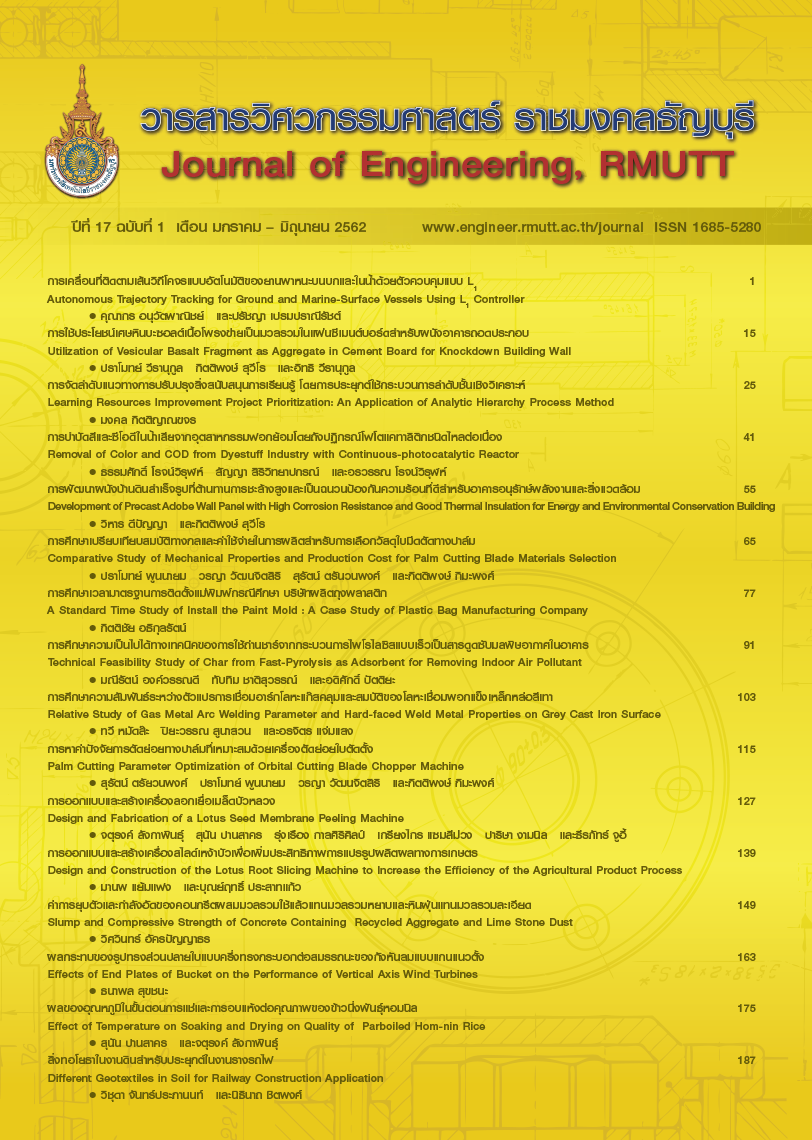ค่าการยุบตัวและกำลังอัดของคอนกรีตผสมมวลรวมใช้แล้วแทนมวลรวมหยาบ และหินฝุ่นแทนมวลรวมละเอียด
Main Article Content
บทคัดย่อ
งานวิจัยนี้เป็นการศึกษาความสามารถในการใช้งานและกำลังอัดของคอนกรีตที่ใช้มวลรวมใช้แล้วแทนมวลรวมหยาบจากธรรมขาติ (หินปูนย่อย) ในอัตราส่วนร้อยละ 70, 80, 90 และ 100 โดยปริมาตรของมวลรวมหยาบ และหินฝุ่นแทนมวลรวมละเอียดจากธรรมชาติ (ทรายแม่น้ำ) ในอัตราส่วนร้อยละ 70, 80, 90 และ 100 โดยปริมาตรของมวลรวมละเอียด เป็นส่วนผสม โดยมีอัตราส่วนน้ำต่อวัสดุประสานเท่ากับ 0.65 ทดสอบกำลังอัดของคอนกรีตที่อายุ 1, 3, 7, 14, 21 และ 28 วัน โดยใช้ตัวอย่างทรงกระบอกขนาดเส้นผ่านศูนย์กลาง 150 มม. สูง 300 มม. ผลการทดสอบพบว่าค่าการยุบตัวของคอนกรีตมีแนวโน้มลดลงตามปริมาณการใช้หินฝุ่นแทนทรายธรรมชาติที่เพิ่มมากขึ้น ในขณะที่การใช้เศษคอนกรีตแทนหินธรรมชาติ มีแนวโน้มทำให้ค่าการยุบตัวของคอนกรีตเพิ่มขึ้นเล็กน้อย กำลังอัดของคอนกรีตที่อายุ 28 วัน มีแนวโน้มลดลงตามปริมาณอัตราส่วนเศษคอนกรีตแทนที่หินธรรมชาติที่เพิ่มขึ้น และหินฝุ่นแทนที่ทรายธรรมชาติไม่เกินร้อยละ 80 ทำให้ค่ากำลังอัดของคอนกรีตมีแนวโน้มเพิ่มขึ้น ในขณะที่การใช้หินฝุ่นแทนที่ทรายธรรมชาติมากเกินกว่าร้อยละ 80 ส่งผลกระทบให้ค่ากำลังอัดของคอนกรีตมีแนวโน้มลดลง สำหรับแนวโน้มการพัฒนากำลังอัดของคอนกรีตที่มีหินฝุ่นและเศษคอนกรีตเป็นส่วนผสม พบว่ามีแนวโน้มการพัฒนากำลังอัดคล้ายกับคอนกรีตควบคุมที่ใช้ทรายและหินธรรมชาติล้วนเป็นมวลรวม
Article Details
บทความ ข้อมูล เนื้อหา รูปภาพ ฯลฯ ที่ได้รับการตีพิมพ์ในวารสารแนวหน้าวิจัยนวัตกรรมทางวิศวกรรม ถือเป็นลิขสิทธิ์ของวารสารฯ เท่านั้น ไม่อนุญาติให้บุคคลหรือหน่วยงานใดคัดลอกเนื้อหาทั้งหมดหรือส่วนหนึ่งส่วนใดไปเผยแพร่เพื่อกระทำการใด ๆ ที่ไม่ถูกต้องตามหลักจริยธรรม
เอกสารอ้างอิง
Office of The National Economic and Social Development Board. [Internet]. 2016 [cited 2016 Aug 15]. Available from: http://www.cit.or.th (in Thai)
Setthabut C. Concrete technology. Bangkok: 1997. (in Thai)
Chaisakulkiet U, Malai A. Strength development of mortar mixed with fly ash and crushed stone. The Journal of King Mongkut’s University of Technology North Bangkok. 2016;26(1):13-18. (in Thai)
Thapprom T. The study of compressive strength of concrete by using silt stone instead of sand for fine aggregate. A case study on silt stone from Narathiwat stone mine. Princess of Naradhiwas University Journal. 2009;1(2):28-41. (in Thai)
Komenthammasopon S. The investigation of compressive strength of concrete in case study using granite dust from Thai crushing plant as replacement for sand. Princess of Naradhiwas University Journal. 2012;4(3):44-53. (in Thai)
Komenthammasopon S. The investigation of compressive strength of concrete in case study using sieved granite dust from Thai crushing plant as replacement for sand. Princess of Naradhiwas University Journal. 2013;5(1):49-60. (in Thai)
Kingkaew R, Chaijit P, Chotchuay V, Chaihan J. The substitution of sand by stonedust in ready mixed concrete. Journal of Southern Technology. 2015;8(2):55-61. (in Thai)
Chen HJ, Yen T, Chen KH. Use of building rubbles as recycled aggregates. Cement and Concrete Research. 2003;33:125-132.
Poon CS, Shui ZH, Lam L, Fok H, Kou SC. Influence of moisture states of natural and recycled aggregates on the slump and compressive strength of concrete. Cement and Concrete Research. 2004;34:31-36.
Tipyota N. Compressive strength of recycle concrete produced from burnt waste concrete. The 10th National Convention on Civil Engineering; 2005 May. (in Thai)
Tangchirapat W, Buranasing R, Jaturapitakkul C, Chidaprasirt P. Use of rice husk-bark ash in concrete containing recycled concrete aggregates. Engineering Journal of Research and Development. 2008;19(2):60-67. (in Thai)
American Society for testing and Materials. Standard test method for relative density (specific gravity) and absorption of coarse aggregate. ASTM C127-15. 2015.
American Society for testing and Materials. Standard test method for relative density (specific gravity) and absorption of fine aggregate. ASTM C128-15. 2015.
American Concrete Institute. Standard practice for selecting proportions for normal, heavyweight, and mass concrete. ACI 211.1-91. 1991.
American Society for testing and Materials. Standard test method for slump of hydraulic-cement concrete. ASTM C143/C143M-12. 2012.
Junruchai P, Somna R, Supromwan J. Compressive strength and drying shrinkage of concrete using quarry dust to replace sand. The 21st National Convention on Civil Engineering; 2016 June 728-732. (in Thai)
American Society for testing and Materials. Standard specification for concrete aggregates. ASTM C33/C33M-13. 2013.
Bongkodsupapa K, Paijitvijarn C, Duangkaeoand C, Sinthaworn S, Teerajetkul W. Experimental investigation of the effect of aggregate type Cal properties of concrete. The 21st National Convention on Civil Engineering; 2016 June 761-767. (in Thai)


